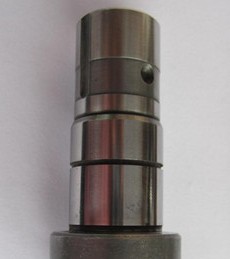
Machinability of stainless steel is by far the more difficult issue, often treated as a secondary property in view of the difficulties of its implementation. Austenitic stainless steels in comparison with steel 42CrMo4 alloy, often adopted as reference material in terms of machinability show a greater tendency to adhere, higher tendency to strengthen, low thermal conductivity and greater resistance to blade during their treatment. To prevent this adverse to apply a number of available resources. Depending on the item, which is to take for protection against work piece material adherence, as well as for the security of micro damage on the cutting edges, directly affecting the lower build quality, the more viscous the material for the production of blades, cutting and machining process is carried out by a much larger spindle speed. Optimal selection of these parameters enables you to significantly compensate for high plasticity of austenitic stainless steels, counter their strengthening during the cutting process, and improve the process of the formation of chips.
 Another essential element, significant from the point of view of the General Machinability of stainless steel is the depth of cut. It should be chosen in such a way as to minimize the risk of notch (formed as a result of the strengthened cutting layers). In addition, poss, the machine should be as soon as possible. On selected parameters of machining , and low thermal conductivity properties of austenitic stainless steel, along with a small amount of material from the twenties. That is significantly more heat comes to the edge of the cutting tool, which should be very hard. If this property is not maintained, the blade is subjected to plastic deformation. Greater wear of the tool cutting edge during the cutting of stainless steel considerably speeds up the crater wear. The resulting chips are strong, long, continuous and difficult to crack, so when you cut, you should use sharp cutting edges with a positive geometry and machining under a layer of umocnioną by work hardening. Interesting changes in the susceptibility of stainless steel machining adds to sulfur alloy. However, any change in the direction of increasing sulphur content of steel significantly reduces its resistance to corrosion. Similarly, a huge impact on the processing properties of stainless steel has nickel content. For example, high-nickel content above 20% has more than doubled lower machinability than steel with a nickel content of around 8%.
Another essential element, significant from the point of view of the General Machinability of stainless steel is the depth of cut. It should be chosen in such a way as to minimize the risk of notch (formed as a result of the strengthened cutting layers). In addition, poss, the machine should be as soon as possible. On selected parameters of machining , and low thermal conductivity properties of austenitic stainless steel, along with a small amount of material from the twenties. That is significantly more heat comes to the edge of the cutting tool, which should be very hard. If this property is not maintained, the blade is subjected to plastic deformation. Greater wear of the tool cutting edge during the cutting of stainless steel considerably speeds up the crater wear. The resulting chips are strong, long, continuous and difficult to crack, so when you cut, you should use sharp cutting edges with a positive geometry and machining under a layer of umocnioną by work hardening. Interesting changes in the susceptibility of stainless steel machining adds to sulfur alloy. However, any change in the direction of increasing sulphur content of steel significantly reduces its resistance to corrosion. Similarly, a huge impact on the processing properties of stainless steel has nickel content. For example, high-nickel content above 20% has more than doubled lower machinability than steel with a nickel content of around 8%.